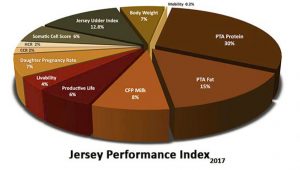Reynoldsburg, Ohio, April 3, 2017—An update to Jersey Performance Index™ that includes new traits and weights will be implemented April 4 when the Council on Dairy Cattle Breeding releases the April official genetic evaluations.
 The new components of JPI 2017 are CFP Milk, a breed-specific trait; and the CDCB Body Weight Composite and Livability traits. The updates were approved by the Board of Directors of the American Jersey Cattle Association at its regular meeting March 11.
The new components of JPI 2017 are CFP Milk, a breed-specific trait; and the CDCB Body Weight Composite and Livability traits. The updates were approved by the Board of Directors of the American Jersey Cattle Association at its regular meeting March 11.
Overall, 53% of the emphasis in JPI 2017 is on production (-5% from the previous version), 27% on fitness (no change), and 20% on functional type (+5%). Traits included and their weights are PTA protein, 30%; PTA fat, 15%; CFP milk, 8%; Functional Trait Index (incorporating Jersey Udder Index™, Body Weight Composite, and mobility), 20%; Productive Life, 6%; Livability, 4%; Somatic Cell Score, 6%; Daughter Pregnancy Rate, 7%; and Cow Conception Rate and Heifer Conception Rate, 2% each.
Significant rescaling in JPI™ and some re-ranking of animals is to be expected as the number of components has been increased, and new economic weights and standard deviations have been applied.
New Traits
CFP Milk (8% of the index) is a breed-specific adjustment to PTA Milk based on the objective that every pound of PTA milk must include 0.088 pounds of combined fat and protein.
CFP Milk is based on the idea that it is preferable to have total yield of pounds fat and pounds protein come from more concentrated milk instead of a greater volume of less nutrient-dense milk.
Production data compiled by the American Jersey Cattle Association and National DHI show that the current combined fat and protein content in 100 pounds milk ranges from 8.51 to 8.54 pounds. The objective of 8.8 pounds is thus a forward-looking target for improving the content of fat and protein while increasing milk yield.
To illustrate the effect of CFP milk on JPI, consider two bulls that have the same combined pounds of PTA fat and PTA protein (160 lbs.), but a large difference in their PTAs for milk (1,600 lbs. vs. 2,500 lbs.). Relative to the target of 0.088 pounds CFP to one pound PTA milk, the bull with a PTA of 1,600M exceeds that concentration and will gain JPI points. The other bull, at PTA 2,500M, transmits more water relative to components and therefore will lose JPI points.
The new CDCB Body Weight Composite is included in JPI 2017 as a proxy for feed efficiency. BWC was developed from actual weights and linear type data from Holstein research herds that also have measured feed intake. CDCB uses those relationships to predict body weight of all dairy cows, using dairy form to account for presence or absence of fat in addition to skeletal size. The penalty of 7% on body size included in JPI 2017 is larger than what is applied in the CDCB Net Merit index. It will select in the direction of moderate-sized, efficient cows.
Livability, introduced by CDCB last August, is a measure of death loss and a subset of Productive Life. The impact of Livability is direct economic loss because cows that die are an expense compared to those sold for beef. The total weight on longevity in JPI 2017 is 10%, split between Productive Life at 6% and 4% assigned to Livability.
Revisions are “Bold, Forward-Looking”
The 2017 revisions are as bold and forward-looking as any ever made to Jersey Performance Index™, according to Neal Smith, Executive Secretary and CEO of the American Jersey Cattle Association.
“By including CF P Milk and a significant penalty on body size through Body Weight Composite, JPI 2017 applies the key principles of Jersey sustainability identified by researchers Jude Capper and Roger Cady in their 2012 Journal of Dairy Science report,” Smith said. “Jersey Performance Index 2017 is a formula for increasing production and improving milkfat and protein levels in the milk, moderating body weight in service of greater productive efficiency, and at the same time selecting for longer herd life, greater fertility, and better udder health.”
The American Jersey Cattle Association, organized in 1868, compiles and maintains animal identification and performance data on Jersey cattle and provides services that support genetic improvement and greater profitability through increasing the value of and demand for Registered Jersey™ cattle and genetics.
Learn more about Jersey Performance Index 2017 in the view-on-demand webinar posted at Green Book Online. For more information on the association’s complete line of services for dairy business owners, visit USJersey.com or connect at facebook.com/USJersey.
Source CDCB/AJCA
